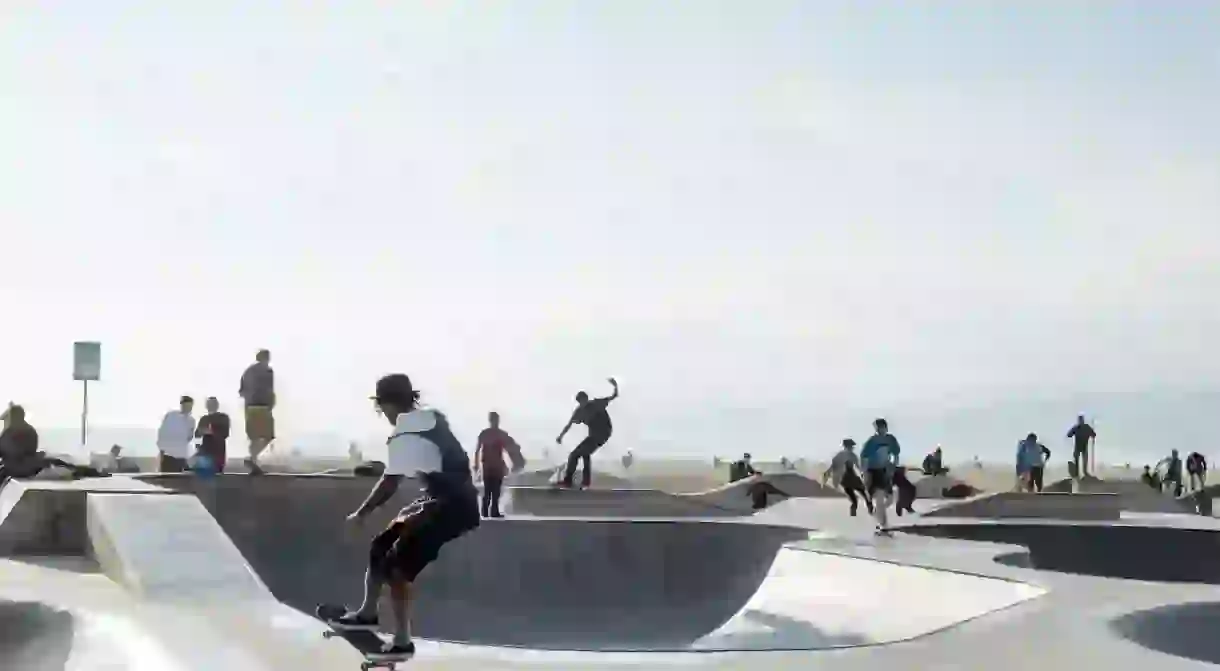Inside Dogtown, the Birthplace of America’s Skateboard Culture

Counterculture enthusiasts from around the world venture to Los Angeles’s west side in search of the Dogtown legends – skaters made famous in the 2001 documentary Dogtown and Z-Boys.
Roaming Santa Monica’s rows of boutique shops and artisanal brunch spots, it’s inconceivable that the neighborhood once belonged to low-income suburbia, where mom-and-pop shops thrived and meals were served à la food cart. Locals knew this area as Dogtown, the focal point of West Coast skate culture that would inspire media representation for decades to come. In this place, a ragtag group of young surfers overcame all odds and rose to stardom, changing skateboarding culture forever.

Beginning in the early 1970s, an abandoned pier called Pacific Ocean Park (known locally as POP Pier), was converted into an unlikely haven of misfits. As dangerous waves crashed the ruins of the old pier, restless young locals religiously surfed around POP, eventually dubbing it The Cove.
Upon its opening in 1958, the pier embodied the quintessential optimism of 1950s America. Less than 20 years later, the same abandoned meeting point transformed into a decaying reminder for locals – a testament to the changing times and changing mood in Los Angeles. In solidarity with the American ’70s, the west side of LA sprouted again, this time with a wave of rebellion in lieu of optimism.
But on waveless days, members of the group known as the Zephyr Surf Team took to the streets with skateboards to practice. Zephyr was the brainchild of local surfboard shop owners Skip Engblom, Craig Stecyk and Jeff Ho of Jeff Ho Surfboards and Zephyr Productions. They opened their doors in 1972, the same year urethane skateboard wheels were invented. More formally, they became known as the Z-boys. Their reputation was for shaping boards, mostly, and dodging burned pilings and sharp remains from the POP at The Cove. Respected and revered, the members of Zephyr’s Z-boys included Jay Adams, Tony Alva, Stacy Peralta, Bob Biniak, Wentzle Ruml, Shogo Kubo, Jim Muir, and the pioneering Peggy Oki, the only woman of the Z-boy group.


When a major drought struck Southern California in the early 1970s, neighborhood swimming pools dried up, many left abandoned or unattended. The imaginative Zephyr team saw this as an opportunity to try something new: The Z-boys began taking skateboards into barren pools, creating a now-iconic image synonymous with their group. Skateboarding as a sport took an evolutionary leap at this moment, birthing a new generation and the next phase in its culture.
The Z-boys began riding the walls of pools, eventually over the rails, making them the first documented skateboarders to catch air. The young community outcasts sparked a small revolution in their impoverished beach town. Today, it’s known as the vert style of skateboarding. Skaters like Christian Hosoi, Tony Hawk and Eliot Sloan emerged from this style of skating, becoming internationally recognized for the sport itself. The Z-boys, as a result, were living legends of the origins of skating.



Today, Dogtown nostalgia is still alive on the streets of Venice Beach – a new generation of skateboarders continue to create their own community and their own mark on west Los Angeles. As a neighborhood spanning all ages seeks out ways to push the limits of the sport, in 2009 they finally found a home worthy of their talent. A $3.5 million skatepark in the heart of Venice opened its doors (or, rather, its expansive park of pools and ramps) a decade ago, and it’s now a hotbed of talent that honors the Dogtown legacy preceding it.

Despite the ongoing shifts that continue to gentrify Venice Beach, Dogtown lives through another generation. From its 2005 film adaptation, Lords of Dogtown, to the artistic manifestations of Z-boys on every other corner of Venice, the counterculture embodied by a team of misfit Californians is as strong as ever. In fact, visitors can experience the magnitude for themselves on any given day in Venice Beach: Just head to the skatepark where passers-by slow to a halt to watch the new and emerging talent.



















